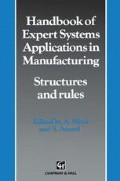Abstract
In the metal processing industry, casting is the most popular means for achieving a desired shape (net shape) in a single step. The casting process is heavily experience-oriented and casting design is an iterative task between casting designers and foundry experts. There is a lot of wastage of resources and time during the design-manufacturing cycle when a part is being engineered. Initial estimates of manufacturability are valuable to the design-er as this avoids costly redesign efforts. With the emergence of abundant computing resources, computer-aided design (CAD)/computer-aided manu-facture (CAM) of casting parts is poised for a big leap forward. Part descriptions of three-dimensional CAD models are in a form of basic geometry and topology to which manufacturing process and engineering analysis cannot be directly applied. Conventional solid models have been concentrated on representing physical information of objects, thus allowing the system to perform mathematical operations. However, recent develop-ments in computer applications to manufacturing processes require more information for decision making in such areas as process planning and manufacturability analysis. Since domain knowledge is usually associated with manufacturing features rather than detailed geometric descriptions, obtaining manufacturing feature descriptions has been one of the most important aspects in CAD/CAM integration.
Access this chapter
Tax calculation will be finalised at checkout
Purchases are for personal use only
Preview
Unable to display preview. Download preview PDF.
References
Bralla, J.G. (1986) Handbook of Product Design for Manufacturing ,McGraw-Hill, New York.
Cadarso, L., Chu, C.N. and Kashyap, R.L. (1991) Finite element simulation of T-shaped castings. AFS Transactions ,99, 369–77.
Choi, B.K, Barash, M.M. and Anderson, D.C. (1984) Automatic recognition of machined surfaces from a 3D solid model. CAD ,16, 81–6.
Davis, R. (1980) Content reference: reasoning about rules. Artificial Intelligence ,15, 223–39.
Dixon, J.R. (1988) Designing with Features: Building Manufacturing Knowledge into more Intelligent CAD systems. Proceedings of ASME Manufacturing Interna-tional, pp. 51–7.
Fu, K.S. (1982) Syntactic Pattern Recognition ,Prentice-Hall, Englewood Cliffs, N.J. 1982.
Gong, X. and Bertrand, G. (1990) A Simple Parallel 3D Thinning Algorithm. 10th IEEE International Conference of Pattern Recognition, pp. 188–90.
Henderson, M.R. (1984) Feature Recognition in Geometric Modeling. CAM-I’s 13th Annual Meeting and Technical Conference, pp. 5.1–5.12.
Herbert, P.J., Hinde, C.J., Lauders, V.A. et al. (1990) Feature recognition within a truth maintained process planning system. International Journal of Computer Integrated Manufacturing ,3, 121–32.
Jakubowski, R. (1982) Syntactic characterization of machine parts shapes. Interna-tional Journal of Cybernetics and Systems ,13, 1–24.
Joshi, S. and Chang, T.C. (1988) Graph-based heuristics for recognition of machined features from a 3-D solid model, CAD ,20, 58–66.
Kotschi, R.M. and Loper, C.R. (1986) Design of T and X sections of castings, AFS Transactions ,535–42.
Lee, D.T. (1982) Medial axis transformation of a planar shape. IEEE Transactions on Pattern Analysis and Machine Intelligence ,PAMI-4, 363–9.
Lee, Y.C. and Fu, K.S. (1987) Machine understanding of CSG: extraction and unification of manufacturing features. IEEE Computer Graphics and Applica-tions ,20–32.
Libardi, E.C., Dixon, J.R. and Simmon, M.K. (1986) Designing with Features: Design and Analysis of Extrusions as an Example. Proceedings of Mechanical Design Conference, pp. 1–8.
Lin, W.C. and Fu, K.S. (1984) A syntactic approach to 3-D object representation. IEEE Transactions in Pattern Analysis and Machine Intelligence ,PAMI-6, 351–64.
Meserve, B.E. (1955) Fundamental Concepts of Geometry ,Addison Wesley, Reading, MA.
Mohan, L. and Kashyap, R.L. (1989) Abstractions in Object-Oriented Data Models: A Formalized Representation Scheme. Proceedings of the First International Con-ference on Software Engineering and Knowledge Engineering, pp. 79–84.
Montanari, U. (1969) Continuous skeletons from digitized images. Journal of the Association for Computing Machinery ,16, 534–49.
Morgenthaler, D.G. Three dimensional digital topology: the genus. TR-980 ,Com-puter-vision Laboratory, Computer-Science Center, University of Maryland, College Park.
Nackman, L.R. (1982) Three-dimensional shape description using the symmetric axis. PhD Thesis ,University of North Carolina.
Requicha, A.A.G. (1980) Representation for rigid solids: theory, methods, and systems. The Association for Computing Machinery Computing Surveys ,12, 437–64.
Requicha, A.A.G. and Vandenbrande, J.H. (1989) Form Features for Mechanical Design and Manufacturing. Proceedings of ASME Computers in Engineering Conference, pp. 47–52.
Spooner, D.L. and Hardwick, M. (1988) A conceptual framework for data manage-ment in mechanical CAD, in Geometric Modeling for CAD Applications ,(ed.M.J.Wozny, H.W. McLaughlin and J.E. Encarnacao), North-Holland, Amsterdam, pp. 317–29.
Staley, S.M., Henderson, M.R. and Anderson, D.C. (1983) Using syntactic pattern recognition to extract feature information from a solid geometric data base. Computers in Mechanical Engineering ,61–6.
Tsao, Y.F. and Fu, K.S. (1981) A parallel thinning algorithm for 3-D pictures. Computer Graphics and Image Processing ,17, 315–31.
Wieser, P.F. (1980) Steel Castings Handbook ,Steel Founders’ Society of America.
Wlodawer, R. (1966) Directional solidification of steel castings ,Pergamon Press, Oxford.
Woo, T.C. (1983) Interfacing solid modeling to CAD and CAM: data structures and algorithms for decomposing a solid, in Computer Integrated Manufacturing ,(ed. M. L. Martinez and M.C. Leu), New York, pp. 39–46.
Yoshiura, H., Fujimura, K. and Kunii, T.L. (1984) Top-down construction of 3-D mechanical object shapes from engineering drawings. IEEE Computer ,32–9.
You, I.C., Chu, C.N. and Kashyap, R.L. (1989) Expert system for castability evaluation: using a fixed-features based design approach. Robotics and Com-puter-Integrated Manufacturing ,6, 181–89.
Editor information
Editors and Affiliations
Rights and permissions
Copyright information
© 1994 Springer Science+Business Media Dordrecht
About this chapter
Cite this chapter
You, I.C., Chu, C.N., Kashyap, R.L. (1994). Expert system for casting design evaluation. In: Mital, A., Anand, S. (eds) Handbook of Expert Systems Applications in Manufacturing Structures and rules. Intelligent Manufacturing Series. Springer, Dordrecht. https://doi.org/10.1007/978-94-011-0703-7_9
Download citation
DOI: https://doi.org/10.1007/978-94-011-0703-7_9
Publisher Name: Springer, Dordrecht
Print ISBN: 978-94-010-4302-1
Online ISBN: 978-94-011-0703-7
eBook Packages: Springer Book Archive

